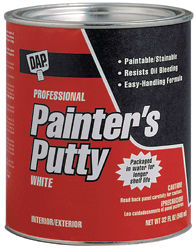You don't the permission to view this video
 Available in either dry or pliable form.
Available in either dry or pliable form.- Repairs cracks, dents, breaks and holes in furniture, wood and concrete floors, woodwork, metal and other interior surfaces.
- In dry form (known as water putty because water must be added), it dries to the shade of new wood but can be tinted with dry color. It sets rapidly, cannot be reworked, dries hard and can be sanded, tooled and finished like wood.
- Pliable Putty (also known as wood putty because it is made from hardwood) is rubbed on wood surfaces before painting to close pores in certain woods such as oak, mahogany, walnut, chestnut, elm, butternut, hickory, ash, rosewood and satinwood. It is not synonymous with patching materials, which fill holes or cracks in finished or unfinished surfaces.
- Most wood putties come in paste form and must be thinned; the container label tells which thinner to use. Putty is brushed on, rubbed, sanded and sealed before finishing.
- Wood putties are available in water-based form, allowing greater safety, rapid drying and less shrinkage. All wood putty patches must be sanded flush with the old surface. Patches can be stained, painted or varnished.



Comments (0)